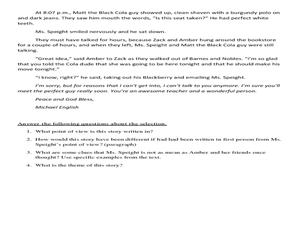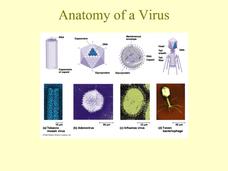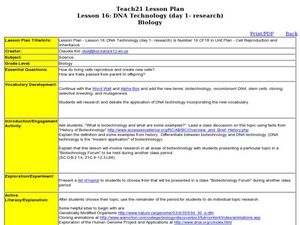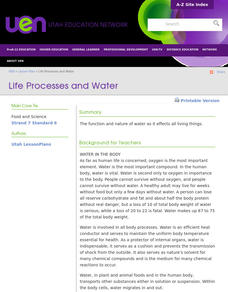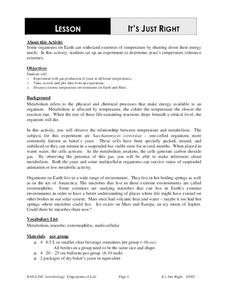Curated OER
Recycling Quick Vocabulary Review Worksheet
In this recycling vocabulary words activity, 3rd graders write recycling words next to the definitions that are provided. Students write words for 15 definitions.
Curated OER
Mutations and Gene Regulation
Teenaged scientists can use this quiz or study guide to show off their understanding of genetic mutations and their causes; includes short answer, multiple choice, matching, and more.
Perkins School for the Blind
Chromosome Models- Karyotyping
Create your own karyotypes with clay in a kinesthetic genome activity. This tactile experience was created for visually impaired pupils, but can be used for all hands-on learners who are beginning to study chromosomes. The preparation...
Curated OER
Oceans in Motion
This simple lesson introduces children to basic marine life as well as to show them the necessity of protecting aquatic environments. Some famous marine life animals are introduced via vocabulary words, then children cut out pictures of...
Curated OER
Beef and Beef By-Products
Students examine the various types of beef and the many uses of its by-products. They increase their knowledge by playing a game of "beef bingo."They discuss what parts of beef animals are their by-products.
Curated OER
What is Life? Demonstrations & Discussion
Display seven items for your biologists to consider. Are they living or non-living? How can you tell? This is a simple outline of what you can display and questions that can be discussed as this topic is explored. One way to use this...
Curated OER
Skin: The Behavior and Health Connection
Pupils explore how personal behavior can affect health, especially the health of your skin. They become better aware of how their personal behavior and the environment can have a considerable impact on their health in general. Students...
Curated OER
Bacteria
Students study the advantages and disadvantages of bacteria. In this bacteria lesson students draw and label the different types of bacteria.
Curated OER
Coral Polyp Party
Students complete a project where they label the parts of a coral polyp and discuss the differences between plants and animals. Students use marshmallows, sprinkles, toothpicks, and more to label their coral polyp.
Curated OER
The Meanest English Teacher Ever
Upper graders will use a reading comprehension worksheet about the meanest teacher to practice comprehension. They will read a 5 page story titled The Meanest English Teacher Ever and answer 4 comprehension questions about it.
Curated OER
Pollination Power
Students go out into the garden and observe pollinating animals through hand lenses. In this pollination lesson plan, students also discuss how animals carry seeds to create new plants elsewhere.
Curated OER
DNA. RNA, and Proteins
A comprehensive five-page quiz or study guide covering DNA and its related processes. Young geneticists will need a strong understanding in order to complete this handout, which includes multiple choice, matching, compare/contrast, and...
Curated OER
Cloning a Living Organism
It's the attack of the clones! Not to worry; these are just plant clones. Teen horticulturalists will enjoy growing their own clone into a plant in an activity designed to be revisited after a few weeks. It is one experiment that kids...
Curated OER
Embryology as Evidence of Evolution
Students observe the two major developmental pathways (protostome and deuterostome). They analyze data regarding differences in nucleotide sequences and construct a phylogenetic tree. They observe the similar evolutionary history shared...
Curated OER
Understanding: Viruses
Students review what they can recall about viruses. They are explained that they are going to work on a project in which they suggest a useful purpose of a virus. Students use print research materials and the Internet to add to their...
Curated OER
Ghost in Your Genes
Students explore DNA microarrays. In this genetics lesson, students model DNA microarrays that are used by scientists. Students work to determine levels of breast cancer genes in patients. They will determine the treatment required based...
Curated OER
Breaking News English: Parkinson Disease
For this Parkinson disease worksheet, students read the article, answer true and false questions, complete synonym matching, complete phrase matching, complete a gap fill, answer short answer questions, answer discussion questions,...
Curated OER
Anatomy of a Virus
This PowerPoint summarizes details about the virus from the structure and reproduction methods to the different modes of infection. Various viral diseases of animals and plants, viroids, prions and genetic origins of viruses are...
Curated OER
Comparing Ovaries And Testes
In this reproductive system worksheet, high schoolers compare specimens of rat ovaries and testes. They complete 5 short answer pre-lab questions, follow an 11 step procedure and answer 5 analysis questions.
Curated OER
Sponges, Cnidarians, Flatworms, and Roundworms
In this simple animals worksheet, learners read information about sponges, cnidarians, flatworms, and roundworms and then complete a chart comparing and contrasting these groups of animals. This worksheet has 11 fill in the blank questions.
Curated OER
Lunch Menu Calories tracking project
In this lunch menu worksheet, students make a spreadsheet where they count the calories of different food items on the lunch menu, chart their findings, and answer short answer questions. Students answer 5 questions.
Curated OER
Lesson 16: DNA Technology
Young scholars research different areas of biotechnology. In this biology lesson, students create a presentation about their research. They debate the topic presented and share their views on the subject.
Curated OER
Life Processes and Water
Explain the properties of water. Identify the properties of water that make it a polar molecule Describe hydrogen bonds and how they differ from covalent bonds Discuss the differences between hard water and soft water Compare the heat of...
Curated OER
It's Just Right
Learners conduct an experiment to determine the temperature tolerance of yeasts. In this biology lesson, students collect data and compare them by plotting graphs. They explain how extreme temperatures affect organisms.











